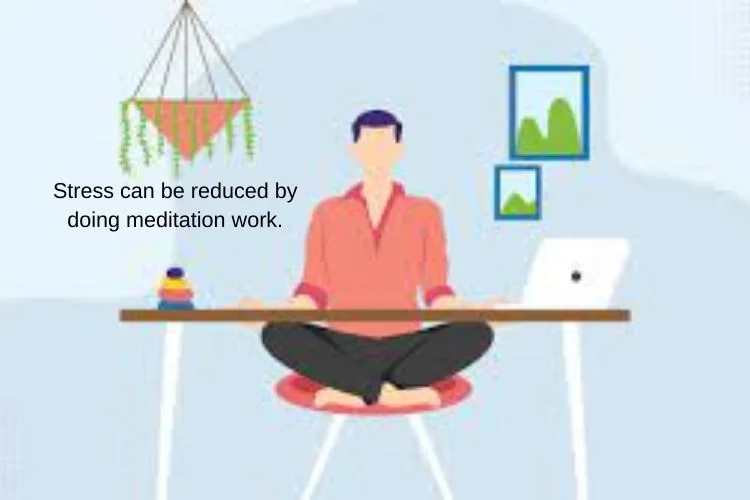काम के लिए ध्यान

हमारा 9 से 5 का समय काफी हेक्टिक होता है। हम अपना काफी समय कार्यस्थल और रास्ते में व्यतीत करते हैं, एक तरह से यह हमारे जीवन में अर्थ भी जोड़ता है। हालांकि सख्त समय सीमा, लंबे दिन, इधर-उधर की चर्चा और चुनौतीपूर्ण बातचीत सभी काफी तनाव पैदा कर सकते हैं। काम में आपकी भूमिका चाहे कुछ भी हो काम तनावपूर्ण हो सकता है। ऐसे में काम करते समय ध्यान मददगार और फायदेमंद हो सकता है। इससे आप अपने मन और शरीर पर आने वाले व्यावसायिक तनाव के प्रभावों को कम कर सकते हैं। इस दिशा में यह एक आसान कदम है।
आज के समय में कार्यस्थल का तनाव, चिंता और थकावट सभी सामान्य घटनाएं हैं। ऐसे लोगों के लिए जिनके पास यह एक सवाल है कि क्या काम करते समय ध्यान (meditation for work) करना संभव है? बिल्कुल आपका कार्यस्थल माइंडफुलनेस और ध्यान का अभ्यास करने के लिए एक बेहतरीन जगह हो सकती है। काम करते समय ध्यान करने से हम केंद्रित हो सकते हैं, अधिक धैर्यवान हो सकते हैं, अधिक ऊर्जावान हो सकते हैं, और अधिक उत्पादक हो सकते हैं। ऐसे समय में जब हममें से बहुत सारे लोग काम पर अपना इतना समय बिताते हैं, ऐसे में ऑफिस काम में से समय निकालकर ध्यान लगाने के लिए सबसे सुविधाजनक और विश्वसनीय स्थान हो सकता है! जानें कि काम पर ध्यान लगाने से आपका काम कितना खुशहाल, स्वस्थ और अधिक कुशल हो सकता है। यहां एक मार्गदर्शिका भी दी गई है, जिससे आपको इसकी शुरुआत करने में मदद मिलती है।
Table of Content
काम पर ध्यान कैसे करें
मेडिटेशन क्यों महत्वपूर्ण है, इस दिशा में ध्यान देने योग्य बात यह है कि, इसमें आपका ध्यान केवल इसी ओर रहता है। आपका ध्यान कहीं बंटता नहीं। क्या यह आपके लिए थका देने वाला और तनावपूर्ण दिन है? ऐसे में जब आप तैयार हों तब वर्तमान क्षण में लौटने से पहले अपनी सांस पर ध्यान केंद्रित करते हुए कुछ मिनट बिताएं। यदि आप ब्रेक नहीं ले पा रहे हैं, तो ध्यान भी इसमें मददगार हो सकता है। बस कुछ गहरी सांसें लें और जब आप तैयार हों, तो अपने काम पर वापस ध्यान केंद्रित करें। यदि आप काम पर ध्यान के लाभों का आनंद लेना चाहते हैं, तो आपको सबसे पहले ध्यान करना सीखना चाहिए। इसलिए, अपने कार्य दिवस में माइंडफुलनेस मेडिटेशन को शामिल करने के कुछ तरीके इस प्रकार हैं :
1. अपने आस-पास की संवेदनाओं और ध्वनियों पर ध्यान दें
आप जहां भी हों, सीधे बैठ जाएं और अपनी हाथों को अपनी गोद में और पैर फर्श पर हो। अपनी सांस को गहरा करें और सांसों के साथ ऊपर-नीचे हो रहे अपने पेट और छाती पर ध्यान दें। एक या दो मिनट का समय लें और जब भी आपका मन भटकता है, अपना ध्यान खुद पर वापस लेकर आएं। इसके बाद सिर से पैर तक शरीर की जांच करें, विश्राम और तनाव के क्षेत्रों को स्वीकार करने के लिए रुकें। अपना समय लें, किसी तरह के जल्दी की जरूरत नहीं है।
जब आप वापस आते हैं, तो अपना ध्यान अपने आस-पास की आवाज़ों और शोर पर केंद्रित करें और वह सब कुछ सुनें जो आपके कानों से टकराता है। वातावरण का अनुभव करने और इसमें गोता लगाने के लिए कुछ मिनट लें। धीरे-धीरे अपनी सांस पर ध्यान लौटाएं और पूरी तरह से तरोताजा महसूस करते हुए अपनी आंखें खोलें। तकनीक आपको जमीनी और तनावमुक्त होने का एक अविश्वसनीय एहसास देती है।
2. त्वरित ध्यान के लिए, ध्यान ऐप का उपयोग करें
यहां मेडिटेशन एप्लीकेशंस की बहुतायत है और आप इसमें से अपने लिए अपना ऐप चुन सकते हैं। अपने प्ले स्टोर पर अपने व्यक्तिगत पसंदीदा एप की तलाश करें। कुछ ऐप में सेल्फ-मेड मेडिटेशन हैं, जिन्हें आप आजमा सकते हैं! जबकि अन्य ऐप्स नए लोगों और शुरूआत करने वाले लोगों के लिए उपयुक्त है।
3. अपनी गतिविधियों की सूची के आधार पर काम से पहले थोड़ा सांस लें
अपनी सांसों को गिनने के लिए खुद को थोड़ा समय दें। पांच गहरी और सुनाई देने वाली सांसें लें, अपनी नाक से सांस लें और अपने मुंह से बाहर निकालें। पहली सांस के अंदर लेते ही अपनी आंखों को बंद कर लें अंतिम श्वास के बाहर निकालने पर उन्हें खोलें। जब आप काम पूरा कर लें, तो हाथ में मौजूद कार्यों को पूरा करने से पहले अपने शरीर को ट्यून करें।
4. वॉकिंग मेडिटेशन आज़माएं
अपने कार्यालय के बाहर एक शांत जगह का पता लगाएं, अपनी आंखें बंद करें और बस अपने परिवेश को महसूस करें। जब तक आप खड़ें हों, अपना ध्यान अपने पैरों, टखनों, पैरों, पीठ के निचले हिस्से, कूल्हों, पीठ, कोहनियों, और अग्रभागों पर लाएं। अपने आप को उतना ही समय दें जितना आपको क्षेत्रों को स्वीकार करने की आवश्यकता है।
अब, धीरे-धीरे अपनी आंखें खोलें और तेज चलना शुरू करें। ध्यान दें कि आपके शरीर के कौन से हिस्से प्रत्येक बेसिक मूवमेंट में लगे हुए हैं और अपने आप को संवेदना में खोने की कोशिश करें। इस तरीके को तब तक जारी रखें जब तक आप शांत और तनावमुक्त न हों। आप अतिरिक्त तनाव को दूर कर सकते हैं और इस सरल तकनीक से अपनी मांसपेशियों को धीरे से खींच सकते हैं।
5. एक खुशहाल जगह की कल्पना करें
एक पल के लिए आप जो कर रहे हैं उसे रोकें और खुद को एक ऐसी स्थिति में कल्पना करें जो आपको खुश करें। यदि यह स्थान वास्तविक या काल्पनिक है, तो यह आपके ऊपर है। अपनी सांस को धीमा करें और अपनी कल्पना को नई संभावनाओं के लिए खुला रखते हुए मानसिक रूप से उस जगह का पता लगाएं। जब तक आप चाहें, तब तक रहें और जब आप तैयार हों तब अपने कार्यालय में लौट आएं।
कार्यस्थल ध्यान के लाभ
यदि आपके कार्यस्थल पर काम का दबाव, मानसिक स्वास्थ्य समस्या आदि की परेशानी है तो तो आपको अपने कार्यस्थल पर मेडिटेशन से फायदा हो सकता है। कार्यस्थल पर माइंडफुलनेस मेडिटेशन आपको स्वास्थ्य और स्वास्थ्य लाभ की एक विस्तृत श्रृंखला प्रदान करती है जो आपको सकारात्मक रूप से प्रभावित कर सकती है।
मेडिटेशन से कैसे काम में मदद मिलती है, आइए इसके कुछ लाभों पर ध्यान देते हैं………..
1. कम तनाव
जब तनाव को अनुपचारित छोड़ दिया जाता है, तो यह पुराने तनाव या जलन को जन्म दे सकता है। दोनों के कई शारीरिक और मानसिक स्वास्थ्य परिणाम होते हैं। कार्यस्थल पर तनाव और मानसिक दबाव को जल्दी से कम करने के लिए ध्यान लगाना एक सरल तरीका है। महज 10 मिनट के मेडिटेशन ब्रेक से कर्मचारियों को अपना दिमाग बेहतरीन करने और अधिक आराम महसूस करने में मदद मिल सकती है।
2. अधिक फोकस और उत्पादकता
ध्यान के केवल 15 मिनट के सत्र के बाद मन का भटकाव कम हो जाता है और एकाग्रता बढ़ जाती है। कल्पना कीजिए कि अगर हम अपनी उत्पादकता में सुधार के लिए काम पर ध्यान के लाभों का उपयोग कर सकते हैं, तो हम जितना अधिक ध्यान केंद्रित करेंगे, हमारा काम उतना ही प्रभावी होगा।
3. आसान टीम वर्क
कार्यस्थल के ध्यान का कर्मचारियों पर सकारात्मक प्रभाव पड़ता है। वे साथ मिलकर काम करने से ज्यादा खुश होते हैं और काम के प्रति भी ज्यादा सकारात्मकता आती है। काम के लिए ध्यान भी आक्रामकता और चिड़चिड़ापन को कम कर देता है। यह टीम के सदस्यों के बीच विश्वास की कमी और खराब संचार के कारण चीजों को मोड़ने में भी मदद कर सकता है।
4. बेहतर जॉब संतुष्टि और जुड़ाव
माइंडफुलनेस और कार्यस्थल की व्यस्तता का एक अच्छा रिश्ता है। अध्ययनों से पता चला है कि काम करते समय ध्यान से नाटकीय रूप से जॉब सेटिस्फेक्शन में सुधार हुआ है। माइंडफुलनेस उन विशेषताओं को प्रोत्साहित करती है, जो नौकरी की संतुष्टि और प्रतिबद्धता को बढ़ाने में योगदान करती हैं, जैसे कि नियोक्ताओं के साथ संबंधों को मजबूत करना, कम तनाव और भावनात्मक संतुलन और सकारात्मकता में वृद्धि।
5. कार्यस्थल संबंध
सामाजिक संपर्क और पेशेवर कनेक्शन कर्मचारियों के महत्वपूर्ण स्वास्थ्य और कल्याण के पहलू हैं। समूह में किए गए काम के दौरान ध्यान सामाजिक संपर्क और अपनेपन की भावना को प्रोत्साहित करने का एक सरल तरीका है। इसके अतिरिक्त, कार्यस्थल पर माइंडफुलनेस मेडिटेशन, ज्यादा आशावादी दृष्टिकोण और स्वस्थ संबंधों को बनाए रखने की एक व्यक्ति की क्षमता को दर्शाता है।
6. निर्णय लेना
काम दौरान ध्यान तनाव और चिंता को कम करने में मदद करता है, उसी तरह यह कर्मचारियों की निर्णय लेने की क्षमताओं को बढ़ाने में मदद कर सकता है। कर्तव्यनिष्ठा का अभ्यास मस्तिष्क को अधिक बारीकी से ध्यान केंद्रित करने और दिए गए परिस्थितियों पर अधिक प्रतिबिंबित करना सिखाता है।
7. स्थिरता
माइंडफुलनेस स्थिरता के विकास में मदद करता है। लगातार तनाव प्रबंधन मुकाबला कौशल सिखाना, जैसे लगातार ध्यान, कर्मचारियों के भावनात्मक तनाव को बेहतर तरीके से काम करने में सक्षम बनाता है।
8. मेमोरी
ध्यान सीधे मस्तिष्क के कार्य और संरचना को प्रभावित करता है। यह इसे उन तरीकों में बदल देता है जो ध्यान अवधि, एकाग्रता और स्मृति को बढ़ाते हैं।
9. नेतृत्व
कर्मचारियों को काम करते समय दैनिक ध्यान में संलग्न होने से लाभ होगा। ध्यान उनके कार्यस्थल की उपस्थिति (Meditation at workplace) में सुधार करेगा और आत्म-जागरूकता, भावनात्मक बुद्धिमत्ता और सकारात्मकता को बढ़ाकर उन्हें अपनी टीम के लिए अधिक निर्णायक लीडर बनने में मदद करेगा।
10. मानसिक कल्याण
शोध से पता चला है कि काम करते समय ध्यान चिंता, अवसाद और भावनात्मक संकट से निपटने में बहुत मदद करता है। यह हमारी भावनाओं के नियमन में सहायता करता है। यहां हम सीखते हैं कि तनाव और कठिनाइयों का सामना करने पर शांति से, सोच-समझकर और सशक्त रूप से कैसे कार्य करें, क्योंकि हम कार्यस्थल पर ध्यान करते हैं और कठिन परिस्थितियों के कारण होने वाले नकारात्मक विचारों और भावनाओं से अधिक परिचित हो जाते हैं।
काम के दौरान ध्यान के लिए टिप्स
ईमेल, इंट्रा-ऑफिस चैट सिस्टम और सोशल मीडिया, सभी को हमारे ध्यान की जरूरत होती है और इससे हमारा तनाव भी बढ़ जाता है। इसमें हमारा काफी समय चला जाता है।
सबसे पहले, ध्यान के लिए हर दिन कुछ समय निर्धारित करें। कोशिश करें कि यह हर दिन एक ही समय पर हो।
यदि आपके पास समय कम है, तो अंतिम समय की जल्दबाजी से बचने के लिए कुछ समय पहले व्यवस्थित करने का प्रयास करें।
इसके बाद, एक शांत जगह की खोज करें, यदि जगह सीमित है तो आप खाली कॉन्फ्रेंस रूम, एक साउंडप्रूफ रूम, पास का पार्क यहां तक आपकी कार भी हो सकती है।
इससे कोई फर्क नहीं पड़ता कि आप जहां तक जाते हैं, शांत है, और वहां कम बाधाएं आती हैं।
यदि ज्यादा परेशानी हो रही हो तो ई-मेल ऐप और डिजिटल अलर्ट बंद कर दें।
अधिकांश व्यवसायों में अधिकांश लोग बिना किसी परेशानी के काम से 10 से 15 मिनट का ब्रेक ले सकते हैं।
आप अपने कार्यस्थल में ऐसा करने के लिए अनिच्छुक हो सकते हैं, लेकिन यदि आप इसका सबसे अधिक लाभ उठाना चाहते हैं, तो यह एक आवश्यक कदम है।
इसे इस तरह से सोचें, काम पर 10 या 15 मिनट ध्यान करने से आप लंबे समय में अपनी नौकरी में अधिक उत्पादक और प्रभावी बनेंगे।
यदि आपके कार्यालय का स्थान और मौसम आपको बाहर टहलने के लिए जाने की अनुमति देते हैं, तो पैदल चलने की कोशिश करें, जो आपको अपने काम के बदलाव के बीच में एक संक्षिप्त, उत्पादक ब्रेक लेने में मदद करेगा।
निष्कर्ष
काम पर ध्यान, मुख्य रूप से, आपके स्वास्थ्य और खुशी के लिए जादू कर सकता है। आप विभिन्न तरीकों की कोशिश कर सकते हैं, और कुछ ही समय में आपको इस बात का पता चल जाएगा कि कौन सा आपके लिए बेहतर है। आपको जो भी दृष्टिकोण पसंद है, उसे एक रूटीन बनाएं, और कुछ ही समय में आपको अंतर नजर आएगा।




